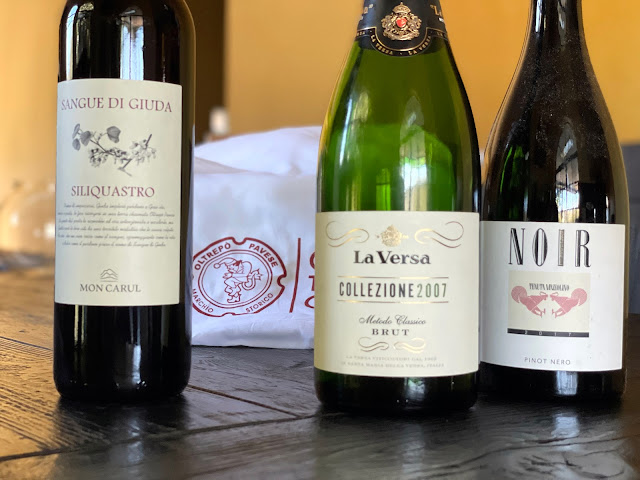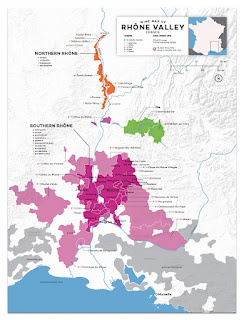October is usually MerlotMe month in the US, and the #WinePW group has a Merlot-centric event although not an official MerlotMe one. Our host this month is Camilla Mann from Culinary Cam who also graciously arranged for two samples each for a few of us and wrote a Merlot preview teaser. We will meet on Twitter/X on Saturday, 14 Oct at 8 AM PST as usual so come over and look for or join in under #WinePW. The list (and links) of all of us who've written about Merlot is at the end of this post so do scroll over to browse each article and be inspired with some unique pairings!
Samples or not, opinions, as always are all mine.
KASHMIRI PANDIT FOOD
In India, there's no concept of "Indian" food. We refer to the overall region from where the cuisine is, e.g. Kashmiri, Bengali, Punjabi, Rajasthani etc. food, or sometimes, more granularly, by subregion, town, or community. E.g. Konkani, Tamilian Brahmin, Saraswat Brahmin, Jain, etc. food. Even though overall the cuisine of the Indian subcontinent is rooted in the texts of Ayurveda there are nuances and vast differences in the cuisine of each state based on regions, subregions, ingredients, weather, seasons, geography, and each community's cooking style. Even the herbs and spices vary. Also, although we use countless spices and herbs, it's not as if all of India starts eating chillies the moment they wake up - our food is spiced with spices, it is not spicy. Chillies did not exist in India until the 15th century so....
And so, just like every other state in India, Kashmiri food is quite unlike any other cuisine of India. In Kashmir, a cold mountainous Himalayan state full of valleys and lakes, the main herbs and spices are asafoetida, Indian bay leaves, various types of Indian cardamom, black pepper, long pepper, Indian cinnamon, cloves, fenugreek seeds, dried ginger, fennel seeds, Kashmiri shallot, to name just a few, and then since ~1498, Kashmiri chillies, which are medium spicy and of a deep but bright red colour. Cockscomb flower, alkanet root, and saffron are also used, for both, flavour and colour. And dried fruits and nuts are also used in a number of dishes as are lotus root and bottle gourd (vegetables), and yoghurt.
Kashmiri Pandits are the native inhabitants of Kashmir and because of its location it's a place that has been invaded multiple times throughout history. Pandits are Brahmins/Hindus and large numbers have been forcefully converted to Islam, by invading Persian and other Muslim armies. The ones that remained have been victims of genocide by Muslims or forced out to other parts of India and the world, as recently as 1990. However, they have taken their culture and cuisine with them. Unlike many Brahmins, Kashmiri Pandits do eat meat (usually lamb/goat) and freshwater fish, because that is what is available when vegetables are not, and like all Brahmins, they do not eat garlic and onions. In fact, some of the most exquisite Kashmiri Pandit dishes are meat-based. With lavish use of aromatic herbs and spices, Kashmiri Pandit cuisine is particularly well suited to enjoying with wine.
MERLOT IS MERLOT, NO?
No, luckily. Merlot is originally French (from Bordeaux) and is a cross between Cabernet Franc and Magdeleine Noire des Charentes. It is not half as finicky a grape as Pinot Noir and is grown in every wine-growing region of the world including, these days, China. Merlot was originally - and still is in the Old World wine regions - a blending grape, providing lush fruit and a full body, with low tannins and low acidity to a wine. With aromas/flavours of blackberry, black cherry, violets, mint, and chocolate. And vanilla and baking spices (if aged in new oak).
Even with the same grape, Merlot styles vary vastly around the world depending on soil, climate, and winemaking. Two main Merlot wine areas in the US are California and Washington state. In California, generally Merlot from Napa (or any other warm climate/Valley region) is higher ABV, very fruit forward, jammy, and the ever-present baking spices due to aging in new oak. Coastal or higher altitude CA Merlot on the other hand, is higher acid, not cloyingly fruit-forward, and layered.
In Washington state, Columbia Valley produces the largest quantities of Merlot (some of it very good quality) but some of the exceptional Merlot comes from Walla Walla, Red Mountain, and Horse Heaven Hills in WA. In general, compared to CA, WA Merlot has higher tannin, crisp acidity, and is not overly fruit forward or jammy. Both can pair quite well with a variety of cuisines but because it is more complex, WA Merlot offers much more flexibility in food pairings.
MERLOT AND KASHMIRI PANDIT FOOD
2020 L'ECOLE NO. 41 MERLOT, COLUMBIA VALLEY
82% Merlot, 15% CABERNET FRANC, 2% MALBEC, 1% PETIT VERDOT
ABV 14.5%
SRP ~$27
Established in 1983, L'Ecole No. 41 is a third generation artisan winery based in a historic schoolhouse in the Walla Walla Valley, WA. They make "premium" wines with the typicity of Washington state (climate, soil, etc.) but it is also their masterful winemaking that results in wines with excellent structure, acidity, colour, and balance.
The grapes for this wine were hand-harvested, crushed, and fermented in stainless steel before being aged in small oak barrels (15% new oak). Greater than the sum of its parts this blend includes grapes from at least 6 different vineyards and has the broader Columbia Valley designation, but it has a vibrant crisp acidity, and is complex and balanced. This wine is delicious!
Looks: deep purple
Nose: dark fruit - plum, black cherry, dried red roses, faint earth, and cedar
Palate: Echos the nose, and also has a cola note on the mid-palate. Smooth but firm tannins, juicy medium+ acid, and a long, elegant finish. Overall, very reminiscent of an Old World Merlot blend.
2022 GOLDSCHMIDT, GUIDESTONE RISE VINEYARD CHELSEA, ALEXANDER VALLEY
100% Merlot
ABV 14.5%
SRP ~$25
The Goldschmidts are originally from New Zealand and now based in Sonoma County. The whole family including the 5 grown kids are actively involved in the winery - a true family enterprise. This winery is new to me but I am very much looking forward to trying their other wines and maybe visiting the winery as well.
Looks: deep purple, nearly opaque
Nose: dark fruit - blueberry compote, ripe cherries, stewed prune plums, maybe baking spices
Palate: Echos the nose, and is very fruit forward. Supple tannins as you'd expect in a Merlot, medium acid. Overall this Goldschmidt Chelsea Merlot is a fleshy wine with a long enough finish that, after at least 5 years in the bottle would maybe calm down enough to pair seamlessly with complex food.
Pairing: We had the 2020 L'Ecole No. 41 and the 2022 Goldschmidt Chelsea Merlots with Kashmiri Pandit food. The comparatively low tannins in Merlot combined with it's fruit forwardness and plush mouthfeel pair very well with Kashmiri food. Of the two, the L'Ecole was exceptional with the food. Kashmiri Pandit food is very aromatic and complex thanks to the variety of fresh and dried spices, many of which are similar to the baking spices note in (good, well made) American Merlot. Because it was a blend rather than 100% Merlot, the acidity, juiciness, and complexity of the L'Ecole No. 41 was a perfect complement to the food. Both wines paired splendidly with the food... hard to say whether the food bolstered the wines or vice versa, but L'Ecole was a clear winner.
THE FOOD
We had mutsch, al yakhni, and ghee-roasted Basmati rice (descriptions below). We also had roasted potatoes... not exactly an Indian ingredient at all, but I needed to use them up.
The dishes are: Mutsch (hand-formed lamb kebabs) in a sauce of mustard-oil tempered spices - Indian bay leaves, cloves, Indian cinnamon, black cardamom, and powdered dry ginger-fennel seeds-Kashmiri chillies, with Kashmiri garam masala (a highly aromatic powdered spice mix always added to a dish as a finish). Al yakhni, bottle gourd in a fragrant sauce of cloves, green cardamom, cumin, and powdered dried ginger and fennel tempered in mustard oil, cooked in yogurt, and finished with Kashmiri garam masala. Ghee-roasted Basmati rice is exactly that. Basmati rice soaked for 1 - 24 hours, drained and sautéed in ghee (NOT clarified butter, please), and cooked.
I've compared the two starkly different American Merlot samples I received, and to be really wowed see what the other #WinePW writers paired with Merlot.




















